
The first thing I recommend is that you get your dog a crate. Your dog should be in his crate at night, during the day when you are at work, or if you are otherwise occupied and cannot keep an eye on him. Don't worry; this isn't permanent. Soon, you should be able to leave him loose in the house without worry, but until he's trained, he needs to be crated when he cannot be watched. You can move the crate around so that he's in your bedroom at night & in the living room during the day, etc. if you like.
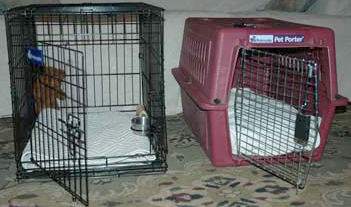
I prefer the plastic crates with a wire door, because many dogs seem to prefer them to all-wire crates (they are more den-like), and they contain messes better than all-wire crates. They are lightweight, so they're easier to move around than wire crates, and are also airline approved if you ever have to fly somewhere with your pet. I've found that Wal-Mart is the cheapest place to get a crate like this, if you cannot find one at a yard sale. The only downside to a plastic crate is that some dogs will try to chew them, and they do not collapse down for storage like some wire crates do. Of course, if you or your dog prefer a wire crate, there's nothing wrong with using one.
To determine what size crate you should buy, scroll down to the 'Relevant Links' section, where there is a link to a chart that will tell you what size to get based on the breed of dog you have.
Your dog's crate should be only large enough to allow him to stand, turn around, and lie down in comfortably. You don't want it to be too large because he may start to use the bathroom in one end of it.
You should not put any kind of bedding material in the crate while you are attempting to housetrain your dog. Often, dogs will soil their crates if they have bedding in there, because the bedding will soak up the mess and/or they can 'hide' the mess underneath the bedding. Once they are crate trained and housebroken, however, you may put bedding in the crate if you wish.
If your dog is not accustomed to being crated when you get him, you may need to teach him that being in the crate is not a punishment, so that he doesn't bark and whine and keep you (and your neighbors) awake all night. For instructions on how to desensitize your dog to the crate Click Here.
You should not expect your dog to be able to hold it for excessive periods of time without a break. For puppies, the general rule is that they must be given an opportunity to relieve themselves at least once in the number of hours that corresponds with their age in months. For example, if you have a 10 week old puppy, that means he's 2-1/2 months old, which tells you that you need to give him a chance to potty at least once every 2-3 hours. If you can do it more often, there's absolutely nothing wrong with that! Of course, you'll want to keep an eye on the dog at all times so that if he starts showing signs of needing to go potty, you can take him out, even if it hasn't been X-number of hours. Another general rule with puppies is that they will use the bathroom when they first wake up, after they have been playing or running around, and usually within 20 minutes of eating. Do not expect your puppy to be able to hold it all day while you're at work until he's at least 5-6 months old. Some breeds (mainly the smaller ones) must be even older than that before they can be expected to go all day without a break. If you can come home for lunch and let them out, DO.
If you have a young puppy and work outside the home, making it impossible to let the puppy out as often as he needs to be let out, then - depending on his age - you may want to consider having someone come over and pet-sit for you (or taking him to their house while you're at work), enrolling him in a 'doggie daycare' facility, or putting him outside in a secure enclosure/kennel during the day (if it's not too cold/hot, and if it's safe to leave him outside), or in an exercise pen (x-pen) in the house. The reason for this is because you don't want him learning that it's okay to potty in his crate, and he will if he's left in the crate all day and he's younger than 6 months of age.
If you decide to put him in an x-pen in the house whenever you have to leave, make sure it's on an easily cleanable surface. Put his crate on one side, and a potty area on the other. I highly recommend using a large cat litter pan, with a 'wee wee pad' inside it. If you want to place newspapers on top of the pad, that's fine. The reason I recommend using a pan is because it gives the dog very clear boundaries so that they do not get into the habit of 'missing' the pad or papers. It also makes cleanup much easier, and if you want to later teach the dog to go outside to do his business, all you have to do is simply remove the pan and the dog is less likely to seek out pieces of paper or other inappropriate things to potty on, because he's conditioned to going in a pan. There is a special 'litter' that is made for dogs, but it's not cheap, and some dogs try to eat it. I've found that it's easier and more economical just to use pee pee pads or newspapers instead. If you have a male dog, then you might want to consider the type of cat litter pan that has a covered 'roof' on it. Cut the top off, but leave the sides, so that if your dog wants to lift his leg to pee, he won't be peeing outside the box!
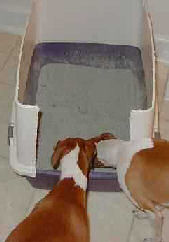
If you have a large dog or puppy, and a cat litter pan is just not big enough, you can make your own litter box by cutting away part of a large plastic storage container so that the dog can easily step into it. You can either cut it down so that it resembles a cat litter box that is the same height on all sides, or you can simply cut out a 'door.' This is especially helpful for a male dog, so that he can hike his leg on the interior wall of the litter box, like what is shown in the picture below.
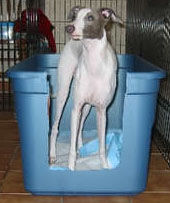
You can also use the top or bottom of a plastic crate if you like, as pictured below:
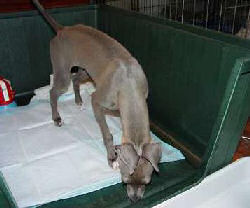
Do not have the front of the crate facing the potty area, in the x-pen. Instead, place the litter pan and crate so that the longest sides of each are parallel to one another.
Also, you don't want a lot of space between the crate and the litter pan, or the dog may just potty on the floor in between the two. Use your own discretion here.
While the puppy is in the x-pen, you may provide water if you wish, in a dish located outside the back of the crate, but no food. You can, instead, give him a Kong or Nylabone to play with and chew on in your absence. Both are durable enough so that you should not have to worry about him chewing pieces off and swallowing them.
When you are at home, you should NEVER take your eyes off the dog, even for a split-second. You can use baby gates and/or closed doors to keep him confined to the room you are in, or you can leash him to you. You may want to consider letting him drag a 6ft leash even if you are using the baby gates and/or doors to keep him nearby, so that IF he starts to go potty on the floor, you have a way of getting him quickly to the litter pan or outside. When you catch him in the act, make a sudden loud noise, either by clapping your hands together, or with your voice (don't say the word "NO," just make a noise, like "aaht," for example) to startle the puppy, which should make him stop what he's doing. Then, use a happy voice to encourage him to follow you to the door or potty pan. If he doesn't come along, then gently 'tug, tug, tug' on the leash as you encourage him with your voice - don't drag him. You don't want to go and pick him up unless you absolutely HAVE to, because you don't want him to get into the habit of submissive urination as you approach to pick him up, and you want him to learn to go to the door or potty pan on his own when he feels the urge to 'go.'
Once you get to the potty pan or out the door, hold onto the leash so he cannot run away or decide he wants to play instead of going potty. Say a short phrase that you want him to associate with going potty, one time when you get him to the pan or spot out in the yard that you want him to 'go' in, and then whenever he starts to go potty, begin repeating the phrase over and over in the same tone of voice each time until he's finished. I tell my dogs to "Go hurry," but you can use whatever phrase you want, as long as it's short and to the point, and doesn't closely resemble an obedience command. As soon as he finishes, praise him in a happy tone of voice and let go of the leash (if it's safe to do so, if you're outside). Play with him and be silly for a minute or two before going back in. You want it to be clear to him that going potty outside or in the potty pan makes you VERY VERY happy!! If he has not gone to the bathroom within 5 minutes when you take him outside or to the pan, then simply take him back inside without praising him or saying anything to him, and just drop the leash and walk away from him when you get back indoors. If you're already indoors (if you're pan training), just drop the leash and walk away. Ignore him for a few minutes, but pay attention so you're ready to whisk him back outside or to the pan if he starts to show the signs!
If you happen to find a spot where the dog has gone to the bathroom on the floor in the house, but you did not actually SEE him making the mess, it is extremely important that you NOT scold him. He will have no idea why he's being scolded, even if he did it just 1 second before you walked in and found it. Simply clean it up with an enzymatic cleaner (such as Nature's Miracle, and smack yourself with a rolled-up newspaper for not paying better attention to him! Hee hee!
If you're training your dog to potty outside, it's very important that you ALWAYS take him out on a leash. This is so that you can control him and keep him from becoming distracted and 'forgetting' what he's out there to do. It also ensures that you're able to praise him the moment he does the deed, and it allows you to be certain that the dog has, in fact, gone to the bathroom while he was out there!
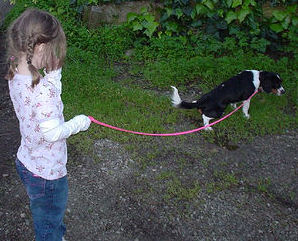
Too many people just open the door and let the dog out, then go about their business for a few minutes (or longer) before letting him back in. During the time he was outside, he could have been chasing leaves, digging a hole, barking at the neighbors, rolling in something smelly, or just sitting at the door wondering why he was out there alone. Then, as soon as he is let back in, he 'remembers,' "Oh yeah! I need to go potty!" and does it right there in the floor, where he is often yelled at and punished. To prevent all that, just go out with him on a leash until he's 100% reliable. That is, until you can open the door, give your potty command, and watch him go out into the yard and go to the bathroom before returning. When you're just beginning to teach him to go potty outside, keep him on a short, 6ft leash. When he's starting to get the idea of pottying on command, in a specific area of the yard, you can 'graduate' to a longer leash or a retractable one, so he can get used to going potty without you being right next to him.
Most dogs are able to begin sleeping out of their crate at night soon after you begin housetraining them. Bring the crate into your bedroom, and either put a baby gate in the doorway, or keep your bedroom door closed, so he doesn't have access to the whole house. Leave the crate door open, so that if he wants to sleep in there, he can. If you find that he's used the bathroom on the floor when you get up the next morning, that tells you he isn't quite ready to be given that freedom yet. When he can go all night without an accident, outside of his crate, confined to your bedroom, for at least 2 weeks, you can try giving him the run of the house as long as you know he isn't going to tear anything up or get into anything harmful. Personally, I don't give my puppies run of the house during the day until they are at least a year old. Sometimes it's even longer, if they are particularly mischievous. With adult dogs, you're a little safer because they should be over the chewing stage. Once your dog can go all night, with the run of the house, for 2 weeks, you can try leaving him loose, confined to one room or an x-pen, during the day. If he does well at that for 2-3 weeks, you can gradually increase the amount of space you give him until he's got the run of the house. If, at any point, he potties on the floor, that means you've progressed too quickly. Back up a couple of steps for a few more weeks before trying it again.
One last thing that is important during housetraining is to put the dog on a food/water schedule, rather than leaving food/water down for him all the time. For puppies younger than 6 months, you can feed them 2 or 3 times a day. For puppies older than 6 months, feeding 2 times a day is fine, and adult dogs may be fed 1 or 2 times daily. Remember to split the dog's daily ration in half (or in thirds if you are feeding 3 times a day), instead of offering him the full ration at each feeding! Believe it or not, people DO make that mistake, and end up with an overweight, unhealthy dog because he has been eating twice or three times what he should be eating in a day.
When you feed the dog, you should give him 30 minutes to eat, and then pick the bowl up and dump whatever he's left in there back into your dog food storage container - I recommend keeping pet foods in an airtight container rather than leaving them in an opened bag, because they stay fresher longer and do not attract pests like bugs and rodents. At the next feeding, do not add back the amount he left in the bowl last time. He will soon learn to eat it all when you give it to him or he will just have to wait. Don't worry, you aren't going to starve him.
You can allow your dog access to water as soon as you get home from work, up until an hour or two before bedtime, or you can offer it to him several times throughout the evening when you KNOW you can keep an eye on him after he drinks, in case he needs to wee-wee. You should not give him water when you put him in his crate.
Sometimes, health problems can cause a dog to regress in housetraining. A few health problems that can cause incontinence include bladder/kidney stones and urinary tract/bladder infections. Old age can also cause leaking of urine, which commonly occurs during sleep. A dog that has just been spayed may also have trouble 'holding it' for a few days, but this problem usually fixes itself once the incision is healed. If it doesn't, you should talk to your vet. If your dog has a leaking problem, in addition to speaking to your vet about it, you may consider letting the dog wear a special 'doggie diaper.' You can buy disposable ones, like diapers for babies, or washable ones that you affix an absorbent pad to the inside of.
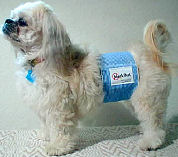
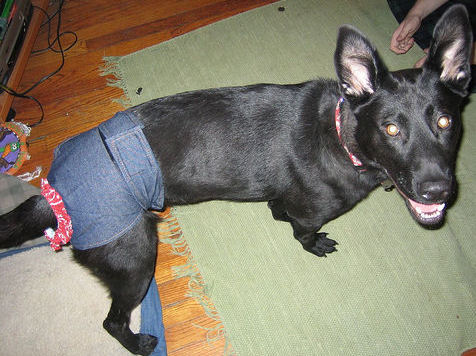

Crate Sizing Chart by Breed
Exercise Pen aka X-Pen
Female Dog Diaper
Male Dog Diaper
My AllExperts Profile